#sustainable progress
Explore tagged Tumblr posts
Text
The Magic of Street-Side Trees. Beauty, Coolness, and Urban Prosperity.
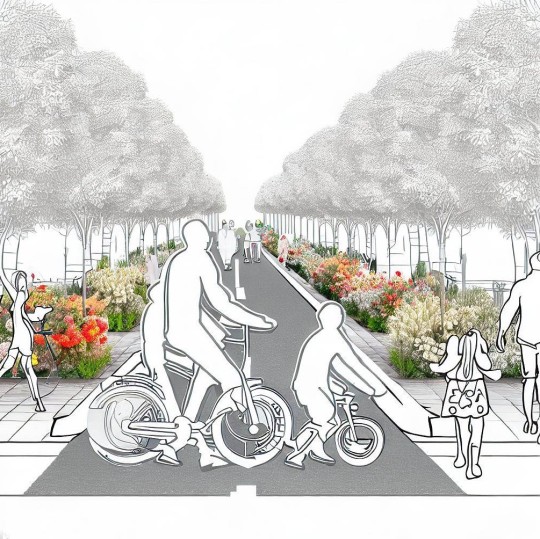
The beauty, coolness, and urban prosperity brought by street-side trees.
Trees lining urban streets are integral elements of the urban landscape, serving multiple ecological roles and socio-economic functions. In general, incorporating trees along the roads in urban areas can elevate the aesthetic appeal, regulate temperatures, and foster prosperity growth. And if our goal is to enhance the role of cities in driving economic growth and fully utilizing human resources, then we must prioritize making tangible improvements to urban environments.

Trees are crucial components for creating appealing and hospitable urban environments that enhance citizens' psychological and social well-being. They play a vital role in reducing air temperature and humidity, which helps alleviate the effects of heat waves and global warming. Trees bear witness to the history, culture, and identity of cities, which they preserve and pass on to future generations. In addition to their undeniable beauty, trees are valuable allies in the fight against climate change.
They provide a range of local benefits that are often ignored beyond the global role of absorbing carbon dioxide. This article aims to increase awareness among readers about the importance of trees for cities and the planet. It seeks to motivate all of us to value, preserve, and protect the urban tree heritage through a participatory and accountable manner that involves citizens and institutions.
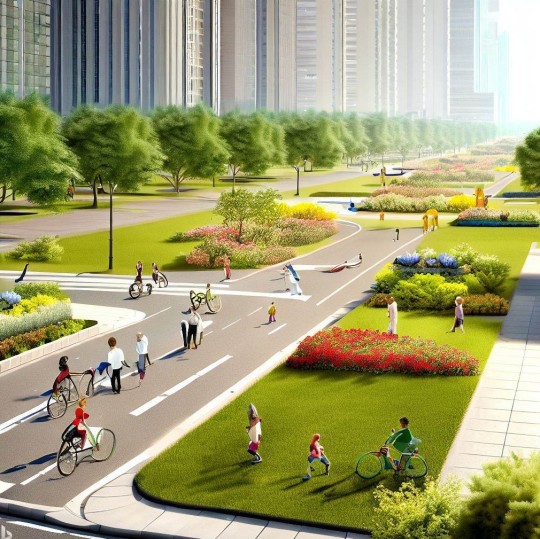
Street-side trees are more than just beautiful to look at. They are an essential resource for cities, providing numerous benefits to residents' health, well-being, and quality of life. In their article on Monocolo, Paolo Massi and Giulia Papaleo highlight the main advantages of trees in urban areas. La magia degli alberi lungo le strade. Bellezza, frescura e prosperità urbana
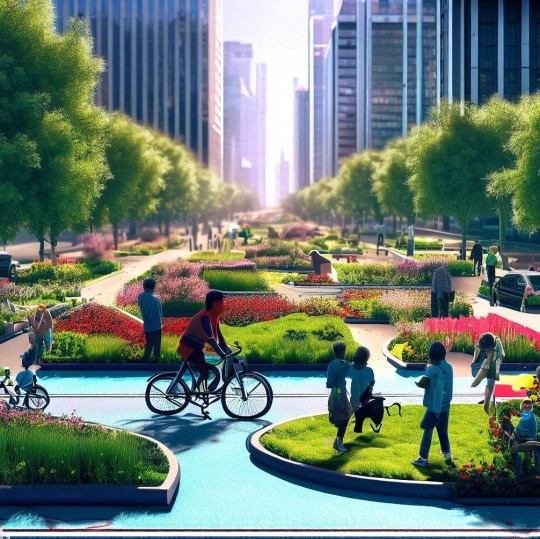
Among the benefits that trees bring to the urban environment, we can mention:
Trees perform ecological, social, and economic functions that contribute to the well-being and development of cities. They help to reduce air pollution by capturing particles, filtering harmful gases, and producing oxygen. Trees also absorb carbon from the atmosphere and store it in their wood, making them beneficial for climate change mitigation. Additionally, trees create shade, cool the air, and reduce energy consumption for cooling buildings. They prevent flooding, improve water quality, and increase biodiversity by providing shelter and food for many species. Trees enhance the urban landscape, mitigate noise, and even increase the value of properties.

Moreover, they promote physical and mental health by stimulating physical activity, reducing stress, and improving mood and concentration.
Therefore, roadside trees are a valuable resource for cities and their inhabitants. It is critical to protect, care for, and increase them through various means, such as public policies, private actions, and guaranteed maintenance over time, recognizing their fundamental role in the quality of urban life so that maintenance, which develops jobs, in particular, is 'guaranteed' over time,

Urban forestation and eco-neighborhoods.
Urban forestation refers to designing and creating green spaces in urban and peri-urban areas to incorporate nature into the landscape. It is important to both develop new green spaces and enhance existing ones.
Eco-neighborhoods serve as an example of sustainable and livable urban environments. They are designed considering the environment and the health of their residents. Sustainability principles are followed to improve the landscape and economic assets of the urban context. The design of an environmentally sustainable neighborhood aims to reduce its environmental impact during construction, throughout its life cycle, and even during decommissioning while prioritizing the comfort of its residents. These neighborhoods are built to improve people's quality of life by emphasizing energy conservation, renewable energy, environmentally friendly materials, reducing water and waste consumption, and promoting sustainable mobility. They are tangible parts of the city that contribute to the well-being of its inhabitants.
In addition, urban forestation is another example of how urban environments can be made more livable and sustainable. We can seamlessly blend nature into the urban landscape by integrating street trees, gardens, and parks. They represent elements of nature that help purify the air we breathe, capturing pollutants, storing carbon, and mitigating the climate of cities.

In summary, street-side trees are not just a decorative element but a proper green infrastructure that improves the quality of urban life. Therefore, It is vital to encourage planting, caring for, and preserving trees in urban areas, with the participation of government institutions, businesses, and residents, in order to achieve a shared vision to promote sustainable progress.
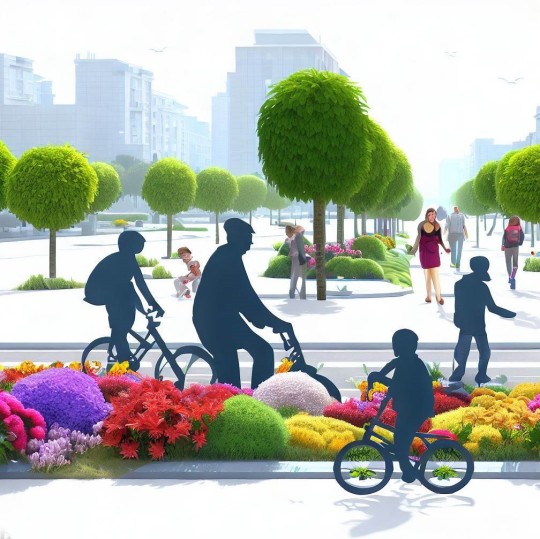
🟠 Italiano
Intro
Gli alberi sono elementi essenziali per creare paesaggi urbani attraenti e accoglienti, che favoriscono il benessere psicologico e sociale dei cittadini. contribuiscono a ridurre la temperatura e l'umidità dell'aria, mitigando gli effetti delle ondate di calore e del riscaldamento globale. Essi sono testimoni della storia, della cultura e dell'identità delle città, che conservano e trasmettono alle generazioni future. Alleati nella lotta ai cambiamenti climatici, oltre alla loro innegabile bellezza offrono una serie di benefici locali che spesso tendiamo a trascurare (al di là dei benefici globali di assorbimento dell’anidride carbonica). Questo articolo quindi ha lo scopo di sensibilizzare i lettori sull'importanza degli alberi per le città e per il pianeta, invitandoli a conoscere, apprezzare e tutelare il patrimonio arboreo urbano coinvolgendo i cittadini e le istituzioni in un processo partecipativo e responsabile.

La magia degli alberi lungo le strade. Bellezza, frescura e prosperità urbana.
Gli alberi sono una risorsa preziosa per le città, non solo per il loro contributo alla mitigazione dei cambiamenti climatici, ma anche per i molteplici benefici che apportano alla salute, al benessere e alla qualità della vita dei cittadini. In questo articolo del Monocolo gli autori Paolo Massi e Giulia Papaleo, vogliono illustrare alcuni dei principali vantaggi che gli alberi offrono alle aree urbane e alle persone che le abitano. La magia degli alberi lungo le strade. Bellezza, frescura e prosperità urbana
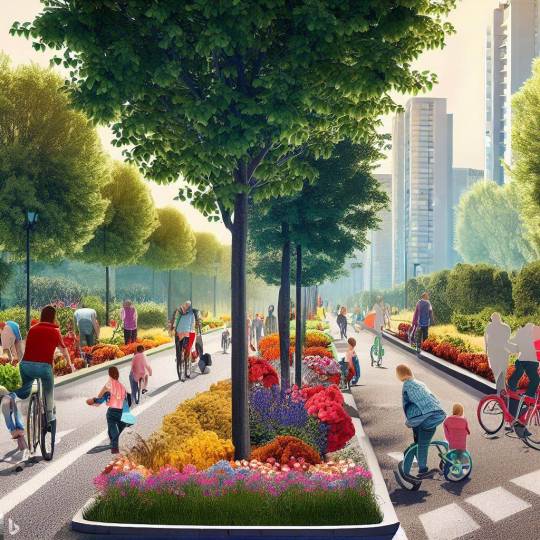
La magia degli alberi lungo le strade dunque non si limita alla loro estetica. Gli alberi sono elementi essenziali per il benessere e lo sviluppo delle città, in quanto svolgono funzioni ecologiche, sociali ed economiche. Tra i vantaggi che gli alberi apportano all'ambiente urbano, possiamo citare:
Riduzione dell'inquinamento atmosferico: gli alberi catturano le particelle sospese nell'aria, filtrano i gas nocivi e producono ossigeno.
Mitigazione del cambiamento climatico: gli alberi assorbono il carbonio dall'atmosfera e lo immagazzinano nel loro legno, contribuendo a ridurre l'effetto serra.
Regolazione termica: gli alberi creano ombra e rinfrescano l'aria attraverso la traspirazione, diminuendo la temperatura e il consumo energetico per il raffreddamento degli edifici.
Conservazione del suolo e dell'acqua: gli alberi riducono l'erosione del suolo, aumentano la sua capacità di infiltrazione e ritardano il deflusso delle acque piovane, prevenendo le inondazioni e migliorando la qualità dell'acqua.
Incremento della biodiversità: gli alberi offrono rifugio e cibo a molte specie animali e vegetali, arricchendo la diversità biologica delle città.
Valorizzazione del paesaggio urbano: gli alberi creano scenari naturali, armonizzano l'architettura, attenuano il rumore e aumentano il valore immobiliare delle proprietà.
Promozione della salute e del benessere umano: gli alberi favoriscono la salute fisica e mentale delle persone, stimolando l'attività fisica, riducendo lo stress, migliorando l'umore e la concentrazione.

Gli alberi e le aiuole a verde lungo le strade sono quindi una risorsa preziosa per le città e i loro abitanti. Per questo motivo, è importante proteggerli, curarli e incrementarli, attraverso politiche pubbliche e azioni private che ne riconoscano il ruolo fondamentale per la qualità della vita urbana affinché la manutenzione, che sviluppa posti di lavoro, in particolare venga 'garantita' nel tempo.
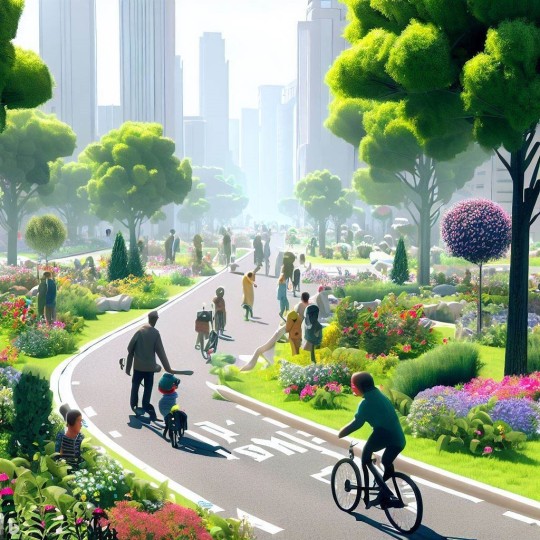
La forestazione urbana e gli ecoquartieri
Con il termine forestazione urbana si intende la progettazione e lo sviluppo di aree verdi urbane e periurbane, facendo della natura un'importante protagonista di questo paesaggio. Chiaramente è importante non solo progettare e sviluppare nuove aree verdi, ma anche rivalorizzare e riappropriarsi di quelle esistenti.
Certo! Gli ecoquartieri sono un esempio di ambienti urbani sostenibili e vivibili. Sono quartieri costruiti nel rispetto dell’equilibrio ambientale e della salute delle persone che vi abitano. Sono conformi ai principi della sostenibilità e puntano alla valorizzazione del patrimonio paesaggistico ed economico del contesto urbano in cui sono inseriti. La progettazione di un quartiere ecosostenibile punta a ridurne l’impatto ambientale: dalla fase di costruzione, al ciclo di vita, fino alla sua dismissione, senza mai dimenticare il comfort di chi lo vive. Si tratta di vere e proprie porzioni di città edificate con l’obiettivo di innalzare il livello di qualità della vita e sono realizzate ponendo l’accento su: risparmio energetico; uso delle energie rinnovabili e di materiale ecologico; riduzione del consumo di acqua e di rifiuti; promozione della mobilità sostenibile.
Inoltre, la forestazione urbana è un altro esempio di come gli ambienti urbani possono essere resi più vivibili e sostenibili. Le alberature stradali, i giardini e i parchi urbani rappresentano degli elementi di natura che contribuiscono a purificare l’aria che respiriamo, catturando sostanze inquinanti, immagazzinando carbonio e mitigando il clima delle città.
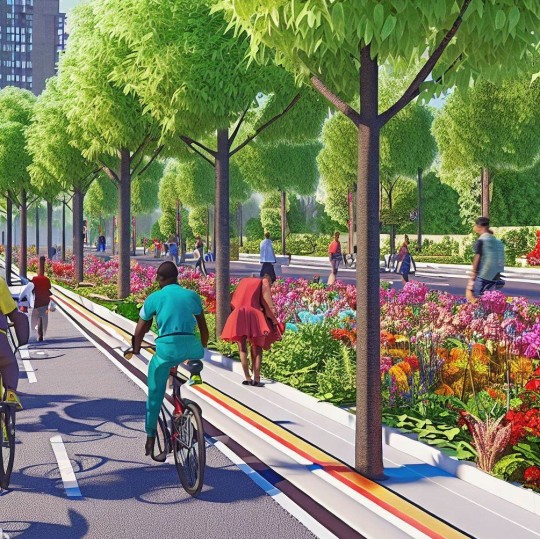
Come si può notare, gli alberi lungo le strade non sono solo un elemento decorativo, ma una vera e propria infrastruttura verde che migliora la qualità della vita urbana. Per questo motivo, è importante promuovere la piantumazione, la manutenzione e la protezione degli alberi nelle città, coinvolgendo le amministrazioni pubbliche, le imprese e i cittadini in una visione condivisa di sviluppo sostenibile.
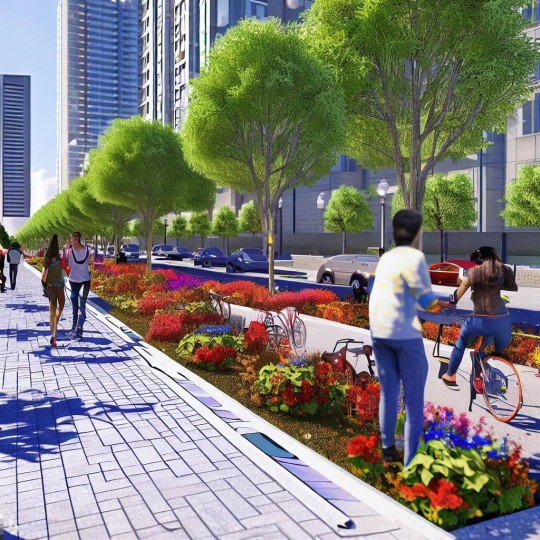
images created by The Board Behind © 2023
More related topics on this matter you might like:
Landscape Architecture: self-reflection on improving and enhancing our cities' run-down suburbs. English /Italian
Give color to the city to celebrate the joy of living.
I appreciate your kind presence and attention on this matter. Thank you for joining us today.
⏩ The Board Behind
#the board behind#sviluppo sostenibile#urban environments#urban tree heritage#ecological restoration#social growth#economic growth#city development#well being#urban living#urban life#heat wave#heat islands#sustainable progress#social innovation
15 notes
·
View notes
Link
In a world that thrives on connections, the push for economic growth is more important than ever, but it's not as simple as it seems. Countries are exploring creative ways to foster sustainable progress and lift living standards for everyone.
From investing in education to cultivate skilled workers, to supporting the entrepreneurial spirit of small businesses, and modernizing infrastructure, the strategies are diverse. Innovation is key, with a strong focus on tech advancements driving competitiveness. Plus, ensuring that growth benefits all segments of society is crucial for stability.
By embracing global trade and smart tax policies, nations can not only grow economically but also create a vibrant ecosystem where everyone has a chance to succeed. The path to prosperity is complex, but with the right strategies, we can build a future that uplifts us all.
Want to dive deeper into investment insights? Sign Up to the free newsletter here www.investmentrarities.com.
#economic growth#sustainable progress#global trade#education investment#entrepreneurship#infrastructure development#tech innovation#competitiveness#tax policy#social equity#small business support#future prosperity#economic development#investing#wealth distribution
0 notes
Text
my mother (jokingly) called me a tradwife the other day because I asked for fiber arts stuff for Christmas 😅 we then had to explain to my dad what a tradwife is.
but seriously, it is crazy to me that there are two parallel movements of young people doing crafts, making their own food/clothing, and pushing for more sustainable lifestyle. But one movement is assigning religious meaning to it and also advocating for a return to “conservative family values” while the other movement is very progressive and doing it for a more environmentally friendly way of living. We’re a weird generation, fellow gen z’s
#tradwife#sustainability#Fiber arts#crafts#homemaking#slow living#eco friendly#gen z#Progressive#just to be clear I am not a tradwife#I am the other side of the movement
38 notes
·
View notes
Text
I finally tried darning!
It's not terrific, but it's a perfect learning project--the bottom of my kid's hand-me-down pajama feet.
I sewed a layer of felt sandwiched between two layers of cotton to the inside of the sole to patch it and provide some cushion, so the darning is just to add longevity to the original outer layer.
I still have a few more spots to do:

But I'm happy for the learning opportunity and to make otherwise great clothes last through another child!
28 notes
·
View notes
Text
thought it's about time I poked my head out of the mire, and confirm that this period of silence just seems to be a part of my process. I can't wait to show you what I am working on. It has taken on a life of its own. It's beautiful and untamed like a wild horse. So much has and is changing. I love it to pieces. !!
#I hope you are taking care of yourselves too!!! I can't wait for tumblr brainrot to take hold again >:3#a rough est: I wouldn't expect The Drop until the 2nd anniversary in march- it seems fitting for a mighty metamorphosis such as this :>#but truly anything could happen- I just want to give myself enough time. learning something new is always slow at the start! and the middle#and at the end. But then!#thank you for all the asks and encouragement<3 you sustain me through tough times. *blows a kiss into the sky* for u#OUROBOROS#ouroboros if#ouroboros-if#interactive fiction#twine game#twine wip#progress update#if you /are/ thirsty for more ouro stuffs come visit our home on discord<3 or take a peep on patreon mayhaps!
198 notes
·
View notes
Text
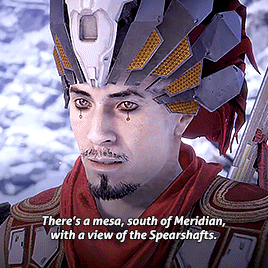
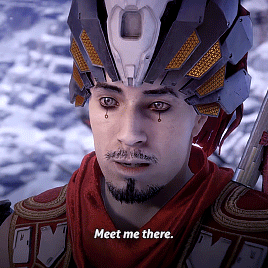


nil + rendezvous
Horizon Zero Dawn (2017) | Horizon Forbidden West (2022)
#nil horizon#niloy#horizon forbidden west#horizon zero dawn#hfw#hzd#hfwedit#captions hard but it's about the growth. it's about the way he has a special spot in mind and an... activity in mind.#and in hfw instead of a duel to the death we are riding the edge of life and death. a dance that holds death close at the perfect distance#repeatable and therefore perpetual. they can race again and again. death is a one time thing.* before bringing up the mesa he mourns#the loss of bandits to kill and seems to not see any further... reason to be alive. he will not kill innocents. he invites aloy to the mesa#with the intention of dying by her hand. because she is his partner. his equal. instead she spares him.#saying she doesn't think he has a death wish and that she sees there's a need for him in the world. that is. an earth shattering#thing to hear. it's no wonder he feels restless after the battle of meridian. aloy has disappeared so there really isn't anything left for#him in the east (not yet anyway. i have thoughts about post-hfw progressions but i digress). he has a reason to stay alive (aloy)#but not a purpose. certainly nothing to fulfill his thrill-seeking itch. so he heads west. and finds the racers.#*he mentions wishing he could kill bandits more than once as well. he wishes for repeatability. sustainability. bc there is so much going o#in his head and i think killing soothed it to an extent. but also perpetuated the issue obviously. racing soothes his demons without the#negative repercussions..... i think i am done now
111 notes
·
View notes
Note
Wonderful blog! Have you read the book Factfulness by Hans Rosling? It's from 2017 so the diagrams in it are a bit outdated, however there's the site Gapminder that he founded that keeps up to date. It's about using statistics to prove that things DO improve over time, and also how to process the constant influx of bad news and put it into perspective.
Thank you!
I have not heard of it, but it sounds extremely up my alley!
The book is here, for anyone else who wants to check it out!
84 notes
·
View notes
Text
Lancer fans are a different breed of ttrpg players, not even dnd fans actually lie about what is literally in the core rule book
#meposting#ttrpg#dnd#lancer rpg#union literally has brainwashed alien slaves this is barely acknowledged#union isn’t even a utopia in progress or whatever lancer fans say to ignore the fact that their fav owns slaves#union is actually a good example of social democracy where the core is pretty nice#but that’s only sustainable by imperialist extraction of resources from the periphery
3 notes
·
View notes
Text
tbh I am still a bit afraid of overhead squats . my wrists ...
#my ohp also doesnt progress very quick s its a little hard to get and sustain true weight over me on these#m
5 notes
·
View notes
Text
Thought I might start posting about the winter coat I'm making. In February, in Aotearoa New Zealand. Cuz obviously this is the project to be working on sweating like mad, listening to the musical stylings of an orchestra of cicadas.

I basically started this project to challenge myself with pattern matching and the thickness of this wool fabric (thick but loosely woven, hence the interlining and lining)
My mum called it a Tino Rangatiratanga coat. I didn't see it til she said it, and now I'll never see anything else.

Look at that alignment. This is hand tacked, I'll eventually machine sew it on - this step was supposed to be for pattern matching but I'm showing off because pretty pleased with it.
Side note, I know the diagonals go opposite ways on these front pockets. Twas intentional. I'm having fun.


Lining, and a picture showing the interlining basted onto the sleeve. Lining is fraying like nobody's business, hence why I overlocked all the edges
I haaaaated sewing in that label at this time when it's devastatingly, spectacularly not finished. If this project wasn't already cursed AF this would have jinxed it. But if it was the last step I took, it wouldn't be so nice and easy to stitch down! It's an end fold label! (by Kylie and the machine btw)
I'm not naming the pattern because I don't hold with it. Shell fabric is 100% wool, from the fabric store. interlining is scavenged, mostly from a poncho my mum gave me 15 years ago; made of possum wool which has fallen to the moths. The lining is stash, 100% synthetic - but hey, this garment won't be being washed. No micro plastics, no problems!
#sewing#work in progress#Tino Rangatiratanga coat#The most sustainable fabric is the one already in your stash not getting used for a gosh darned decade
3 notes
·
View notes
Text
Sustain pedal show me the light
#I’ve been cheating and using the sustain function on the keyboard so that I could focus on getting familiar with the keys#but I now basically have to relearn every song lmfaooo#it’s not intuitive for me#I have to mentally say lift every time there’s a chord change#it’ll get easier I’m sure it’s just a bit annoying#personal#piano progress
4 notes
·
View notes
Text
~
#not snz#more musings 📝 / mini vent:#not sure why my social battery is so limited 😭 and also so inconsistent#i feel like i can't sustain the amount of... like continued/consistent enthusiasm i see others giving esp in group settings#i just don't know how to engage in that way without burning out#over the past few weeks i've been stuck in like#a strange state where i can't muster the energy to properly respond to even the people i'm most excited to reply to#which is strange??#(and if that is you i am sorry 😭 i love you and i will get back to you)#i think i can't even like manage to get myself into the mindset of enjoying something for myself (eg. a conversation with a friend)#i think a part of it is the stress from work leeching into my personal life#i feel like i've been working so hard and for such long hours but its the kind of work where the progress i've made is very hard to track??#:( i just want to be off of ******* work so i can work on ******* work again#i also want to get ahead enough on everything in my life so that i write y+v D:#i feel like i haven't had a properly restful day in weeks... even over the weekend i was busy attending to others' needs#i just want a break from it all... but i dont have enough time to take off... but i dont know how much more of this i can take#i remember also feeling during uni like i was drowning#like there were simply not enough hours in a day to deliver everything i promised. it's such an awful feeling#i just feel defeated. like i've felt exhausted for weeks and weeks on end and like i spend every waking hour working on something or other#but ofc there is nothing to do but to keep at it 😭 other people can handle all of this and more#there are so many people i refuse to let down
11 notes
·
View notes
Text
Beyond the Horizon: Unveiling the Unexplored Dimensions of Utopia
The concept of utopia has long been a fascinating subject in philosophy, literature, and social thought, inviting both idealism and skepticism. Derived from the Greek words "ou" (not) and "topos" (place), the term utopia was coined by Sir Thomas More in 1516 to describe an imaginary island where social, legal, and political structures were crafted to create the ultimate society. Since then, utopian visions have not only inspired philosophical discourse but have also influenced various social movements and cultural narratives.

Throughout history, the allure of utopia has sparked humanity's imagination and motivated thinkers to reimagine the possibilities of human civilization. From Plato’s Republic to utopian socialism, these visions have often focused on ideals such as equality, justice, harmony, and happiness. However, conventional utopian thought has often fallen short, trapped within specific ideologies or limited by the cultural constraints of its time.
This essay aims to venture beyond the established ideas of utopia, delving into lesser-known and uncharted dimensions of what a utopian society could truly be. By examining diverse aspects of human life—such as technology, ethics, relationships, and environmental sustainability—this exploration seeks to expand the framework of utopian thinking. Rather than confining utopia to an "ideal place," this approach will consider the evolving, complex, and often paradoxical facets of human society. In doing so, we hope to inspire new reflections on the nature of human progress and the possibilities that lie within our collective imagination.
1. The Foundations of Utopian Thought: A Brief History
The notion of utopia is deeply rooted in human history, with its ideals appearing in religious texts, ancient philosophy, and modern literature. Plato’s Republic, written around 380 BC, is one of the earliest known attempts to outline a perfect society, focusing on justice, education, and the communal good. Centuries later, during the Renaissance, Sir Thomas More's Utopia depicted an ideal society on a fictional island, where harmony and rational governance shaped every aspect of life. More’s work was both a critique of his society and a vision of how humanity could construct a better world.
As time passed, thinkers like Rousseau, Marx, and Saint-Simon contributed to the utopian discourse. Rousseau’s concept of the "noble savage" highlighted a return to nature as an escape from the corruption of civilization, while Marx and Engels envisioned a classless society free from oppression. Utopian socialism, which arose during the 19th century, aimed to restructure society for communal welfare, inspiring various social experiments worldwide. These historical visions underscore the deep desire for a world free from suffering and inequality.
However, traditional utopian ideals have often been restricted by their era’s political, religious, and economic beliefs. Classical utopias were often static, assuming that a perfect society would remain unchanging and fixed. As history reveals, such an approach to utopia risks stagnation, where the rigid structures created to ensure order may suppress individual freedom. This insight has driven the need for a new, dynamic interpretation of utopia that embraces change and the complexity of human life.
2. Reimagining Utopia: The Unexplored Dimensions
The quest for a utopian world cannot be confined to a single model or set of principles; rather, it must account for the diverse and fluid nature of human existence. The following are some unexplored dimensions that expand the concept of utopia:
a) Technological Utopia and Ethical Dilemmas
In today’s world, technological advancement is one of the most influential forces shaping human life. A technological utopia might include AI-enhanced learning, automated industries, and genetically engineered healthcare. However, the integration of technology also raises questions about privacy, autonomy, and ethical responsibility. A true utopia would not only harness technology for the common good but also address its ethical and social implications, ensuring that advancements empower, rather than dominate, individuals.
b) Environmental Harmony and Sustainability
Many traditional utopias neglected the role of the environment, focusing instead on societal structures. In the modern context, a sustainable utopia would prioritize harmony with nature, emphasizing ecological balance and renewable energy. Such a society would redefine “progress” not as economic growth but as the well-being of all ecosystems. This reorientation of values demands innovative approaches to consumption, production, and resource management.
c) Emotional and Relational Utopia
Historically, utopian ideas have largely concentrated on external factors such as politics, economics, and social structure, often overlooking the internal world of human emotions and relationships. In an emotionally attuned utopia, the society would prioritize mental health, personal fulfillment, and meaningful relationships. This utopian vision might include systems that foster empathy, encourage emotional intelligence, and allow individuals the space to explore their true selves.
d) Pluralistic and Inclusive Utopia
A utopia that seeks to truly embrace humanity must be inherently pluralistic, respecting and integrating diverse cultures, beliefs, and lifestyles. This inclusive vision would go beyond the “one-size-fits-all” model of the past to create a society that is adaptable, inclusive, and flexible. It would allow individuals and communities to coexist in harmony, celebrating diversity while nurturing a shared sense of purpose.
3. The Dynamic Nature of a Realistic Utopia
One of the most unexplored aspects of utopia is its dynamic, evolving nature. Rather than a static ideal, a truly utopian society would be a work in progress—an adaptable system responsive to new challenges and opportunities. It would embrace change as a core principle, recognizing that perfection is not an endpoint but a continuous journey. This perspective redefines utopia as a direction rather than a destination, allowing society to pursue ideals while remaining open to growth and transformation.
Conclusion: Envisioning the Future of Utopian Thought
As this parts essay explores the multidimensional aspects of utopia, it will uncover pathways for envisioning societies that embody both harmony and innovation, ideals and pragmatism. The journey toward a utopian future is as much about embracing our imperfections as it is about striving for the ideal. Utopia, as a concept, remains an inspiring yet elusive vision. By expanding the scope of utopian thought to include the ethical dimensions of technology, environmental stewardship, emotional well-being, and cultural inclusivity, we can unlock new ways of understanding what a "perfect" society might look like in our complex, interconnected world.
In reimagining utopia, we are not merely constructing imaginary societies but engaging with the fundamental questions of what it means to live a good life. Through this exploration, we aim to spark a dialogue that challenges our assumptions, expands our aspirations, and, ultimately, guides us toward a world that aligns more closely with our highest values and most profound dreams.
Part 1: The Evolution of Utopia
Since the dawn of civilization, humanity has been driven by the desire for a better world. The quest to envision and create an ideal society, free from suffering, inequality, and strife, is deeply embedded in the human psyche. This search for utopia—an imagined state where everything exists in perfect harmony—has inspired countless thinkers, writers, and visionaries across history. The evolution of utopian thought reflects not only the values and aspirations of different eras but also the persistent desire for human progress.
This first part offers an overview of the key concepts that have defined utopian thought throughout history, examining the influential thinkers who have shaped our understanding of what a utopian world might look like. By tracing the trajectory of utopian ideas and analyzing their impact on society and culture, we can begin to see how these visions of an ideal world have both inspired and challenged our collective imagination.
1. Overview of Utopian Concepts Throughout History
The concept of utopia has taken many forms across civilizations, shaped by each culture’s unique perspectives on human nature, morality, and progress. The earliest records of utopian thinking can be found in mythologies and religious texts, which often depicted paradisiacal realms like the Garden of Eden, Mount Olympus, or the Elysian Fields. These places embodied ideals of peace, immortality, and divine harmony—attributes that would come to define many later utopian visions.
In ancient Greece, Plato’s Republic (circa 380 BC) became one of the first recorded philosophical explorations of an ideal society. Plato’s vision was a society governed by reason and wisdom, with a clear social hierarchy led by philosopher-kings. Although rigid by modern standards, Plato’s Republic laid the groundwork for future utopian thought by proposing that societal structures could be consciously designed to promote justice and the common good.
The Renaissance period, with its renewed interest in humanism and exploration of new worlds, introduced a more expansive view of utopia. Sir Thomas More’s Utopia (1516) marked a significant turning point, as it depicted a fictional island society with egalitarian principles, shared resources, and a rational approach to governance. More’s work, which satirized the political and social injustices of his time, sparked a new genre of utopian literature and popularized the term utopia as an idealized yet unrealized place.
As industrialization transformed the world in the 18th and 19th centuries, utopian thought shifted to address the challenges of modernity. Thinkers such as Robert Owen, Charles Fourier, and William Morris imagined communities that emphasized cooperation, social welfare, and communal ownership, often in response to the exploitation and inequalities created by capitalism. These early socialists introduced the idea that a utopian society could be achieved through collective effort and equitable distribution of resources, laying the foundation for later political movements.
In the 20th century, utopian thought evolved further, incorporating technological advancements and scientific progress. Writers like H.G. Wells envisioned future societies in which technology served as a tool for human liberation, while others, such as Aldous Huxley and George Orwell, offered cautionary tales about the potential dangers of unchecked power and technological control. These dystopian visions served as a counterpoint to classical utopian ideals, highlighting the importance of balancing progress with ethical responsibility.
2. Influential Utopian Thinkers and Their Ideas
Throughout history, a range of visionary thinkers has contributed to the evolution of utopian thought, each bringing unique perspectives to the question of what constitutes an ideal society. Some of the most influential figures include:
a) Plato (427–347 BC)
Plato’s Republic remains one of the earliest and most influential works in utopian thought. His ideal society was a meritocratic system where individuals were organized into three classes: rulers, warriors, and producers. Plato’s focus on education, justice, and the communal good set a philosophical precedent for future utopian thinkers. Although hierarchical, Plato’s vision emphasized the importance of wisdom and virtue in leadership.
b) Sir Thomas More (1478–1535)
More’s Utopia introduced the concept of a society based on rational principles and shared values. His depiction of a self-contained island community with communal property, religious tolerance, and a focus on public welfare was both a critique of European society and a thought experiment on alternative social structures. More’s ideas were radical for his time, advocating a form of social equality that challenged prevailing norms.
c) Jean-Jacques Rousseau (1712–1778)
Rousseau’s belief in the “noble savage” and his ideas about the corrupting influence of civilization influenced a generation of utopian thinkers. In The Social Contract, Rousseau argued for a society based on general will and collective good, asserting that true freedom could only be achieved in a community where citizens actively participate in governance. His work inspired later visions of egalitarian and democratic societies.
d) Karl Marx (1818–1883) and Friedrich Engels (1820–1895)
Marx and Engels envisioned a classless society in which the means of production were owned collectively, aiming to abolish exploitation and inequality. Their vision of a utopian society, articulated in works like The Communist Manifesto and Das Kapital, laid the ideological foundation for various socialist and communist movements. Marx and Engels’ ideas represented a radical shift in utopian thought, focusing on systemic change as the path to a just society.
e) H.G. Wells (1866–1946)
H.G. Wells’ utopian and dystopian novels, including A Modern Utopia and The Time Machine, explored the potential of science and technology to transform society. Wells envisioned a world state that promoted education, health, and social welfare, but he also recognized the dangers of authoritarianism. His work reflected the hope and caution associated with technological progress, influencing future debates about the role of science in society.
3. The Impact of Utopian Thought on Society and Culture
Utopian ideas have had a profound influence on society and culture, inspiring everything from philosophical movements to social reforms and artistic expressions. By challenging the status quo, utopian thinkers have pushed societies to question their values, imagine new possibilities, and strive for change.
a) Social and Political Movements
Many utopian ideals have directly influenced political ideologies and movements. The egalitarian principles in More’s Utopia and Rousseau’s writings inspired the Enlightenment, which in turn fueled the democratic revolutions of the 18th century. Marx’s vision of a classless society catalyzed the labor movements of the 19th and 20th centuries and influenced the development of socialism and communism. Even today, utopian ideas continue to inform social justice movements that advocate for equality, human rights, and environmental protection.
b) Art, Literature, and Popular Culture
Utopian and dystopian themes have become staples of literature and popular culture, providing a lens through which societies examine their values and aspirations. Works like Aldous Huxley’s Brave New World, George Orwell’s 1984, and Ursula K. Le Guin’s The Dispossessed have shaped public discourse around issues of freedom, ethics, and technological power. These narratives reflect society’s hopes and fears about the future, sparking reflection on what constitutes a truly good life.
c) Modern Urban Planning and Architecture
Utopian ideas have also influenced urban planning and architectural design. Visionaries such as Ebenezer Howard, who developed the Garden City movement, sought to design cities that balanced urban and rural environments, promoting well-being and social cohesion. In recent years, sustainable architecture and “smart cities” embody a modern utopian aspiration for harmonious and technologically integrated living spaces that respect both human needs and environmental constraints.
Conclusion
The evolution of utopian thought reveals humanity’s enduring quest for a world that embodies its highest ideals. From ancient philosophy to modern literature, the visions of an ideal society reflect both the dreams and dilemmas of their respective eras. Utopian thinkers have not only expanded our understanding of human potential but have also offered critiques of existing social structures, prompting progress in ethics, governance, and cultural values.
As we continue to grapple with the challenges of the 21st century, the lessons from utopian thought remind us that the pursuit of a better world is an ongoing endeavor. By exploring and reimagining these visions of utopia, we gain insights into the complexities of human nature and the possibilities for creating a society that aligns more closely with our deepest values and aspirations.
Part 2: Utopian Visions: Unconventional Approaches
The journey toward an ideal society has led humanity through many paths, from political reforms and social experiments to philosophical debates and cultural innovations. While classical models of utopia have traditionally focused on social harmony and justice, the complexities of the modern world have given rise to alternative visions. Unconventional approaches to utopia—such as eco-utopias, techno-utopias, and localized communities—present fresh perspectives on how societies might address contemporary challenges. These models diverge from traditional ideals by incorporating diverse priorities, from environmental sustainability to the transformative power of technology.
In this part, we will explore lesser-known utopian models, each offering unique insights into the possibilities of human progress. By analyzing their strengths and weaknesses and examining real-world case studies, we can assess how these unconventional approaches have fared and what lessons they offer for future visions of utopia.
1. Eco-Utopias: Living in Harmony with Nature
Overview
Eco-utopias envision societies that exist in harmony with the environment, prioritizing ecological balance, renewable resources, and sustainable living practices. Unlike conventional utopian models that focus on social and economic structures, eco-utopias view nature as an integral part of human well-being. The philosophy behind eco-utopias challenges the exploitative tendencies of industrial society, seeking a model of progress that respects the Earth’s finite resources.
Strengths
Environmental Sustainability: Eco-utopias prioritize renewable resources, reducing waste, and minimizing the ecological footprint of human activities. These models offer solutions to pressing environmental issues, such as climate change, resource depletion, and habitat destruction.
Community-Centered Living: Eco-utopian communities often emphasize local food production, shared resources, and communal decision-making, fostering a sense of collective responsibility and interdependence.
Enhanced Quality of Life: By reducing consumerism and focusing on quality rather than quantity, eco-utopias advocate a lifestyle that values well-being, simplicity, and meaningful connections over material wealth.
Weaknesses
Economic Challenges: Many eco-utopian models reject consumer-driven economies, which can create challenges in generating sustainable income or funding necessary resources for the community.
Scale Limitations: Eco-utopian communities are often small and localized, making it difficult to scale their practices to larger populations or urban settings without losing their core values.
Potential for Isolation: Some eco-utopias can become isolated from the broader society, making it difficult for residents to access advanced healthcare, education, or economic opportunities.
Case Study: Auroville, India
Founded in 1968 as an experimental eco-community, Auroville aims to be a self-sustaining city where people live in harmony with nature. Residents engage in organic farming, solar energy projects, and eco-friendly construction. While Auroville has faced challenges with funding and governance, it serves as a living example of eco-utopian principles in practice. The community’s emphasis on environmental harmony and cultural inclusivity has inspired similar projects worldwide, demonstrating that sustainable living can coexist with diverse lifestyles and values.
2. Techno-Utopias: Harnessing Technology for Human Progress
Overview
Techno-utopias are built around the transformative potential of technology to solve humanity's most pressing problems. This vision emphasizes the role of advanced technology in creating a society where scarcity, disease, and even death are minimized or eliminated. Key features of techno-utopias include automation, artificial intelligence, genetic engineering, and space exploration. These models view innovation as a means to transcend current human limitations and create a future where people are free to pursue their passions and potential.
Strengths
Increased Efficiency and Productivity: Automation and AI can handle labor-intensive tasks, potentially freeing individuals to pursue creative, intellectual, or personal growth endeavors.
Enhanced Quality of Life: Technological advances in healthcare, transportation, and communication can greatly improve living standards, extend life expectancy, and enhance global connectivity.
Problem-Solving Potential: Techno-utopias hold the promise of addressing major challenges such as climate change, food security, and resource scarcity by leveraging innovative solutions like synthetic biology, vertical farming, and renewable energy.
Weaknesses
Ethical Concerns: Techno-utopias often rely on technologies like genetic engineering and AI, which raise ethical issues regarding privacy, autonomy, and the potential misuse of power.
Inequality Risks: The cost of advanced technology can create disparities, limiting access to only those who can afford it. Without careful regulation, techno-utopian societies risk deepening social divides.
Dependency on Technology: Over-reliance on technology could result in the erosion of essential human skills and create vulnerabilities, especially in the face of technological failures or cybersecurity threats.
Case Study: Songdo, South Korea
Songdo is a purpose-built "smart city" that integrates cutting-edge technology to optimize urban living. With an interconnected network of sensors, Songdo monitors and manages everything from waste disposal to energy use, traffic, and air quality. Designed to reduce energy consumption and improve quality of life, Songdo exemplifies techno-utopian ideals. However, the city’s high costs and reliance on complex infrastructure have raised concerns about accessibility and technological dependency, highlighting the need for inclusive and resilient techno-utopian models.
3. Decentralized Communities: Small-Scale and Self-Sufficient Utopias
Overview
Decentralized utopias prioritize localized, self-governing communities over large, centralized governments. These models advocate for small-scale, self-sufficient living environments where people have autonomy over their lives and resources. Decentralized utopias often emphasize direct democracy, individual responsibility, and voluntary cooperation, challenging the centralized structures that dominate modern society.
Strengths
Community Autonomy: Decentralized utopias empower communities to make decisions based on their unique needs and values, fostering a sense of ownership and engagement.
Flexibility and Adaptability: Smaller communities can respond more quickly to local challenges, making it easier to implement and test new ideas.
Reduced Bureaucracy: Decentralized governance structures minimize bureaucracy, allowing for more efficient decision-making and reducing the potential for corruption.
Weaknesses
Limited Resources: Small communities may struggle to access resources for infrastructure, healthcare, or education, making it difficult to provide residents with comprehensive services.
Risk of Insularity: The focus on self-sufficiency and local governance can lead to isolation, reducing opportunities for collaboration or innovation from outside the community.
Potential for Conflict: Without centralized authority, decentralized communities may face challenges in resolving disputes or maintaining cohesion, especially as they grow in size.
Case Study: Twin Oaks Community, USA
Founded in 1967, Twin Oaks in Virginia is a self-sufficient commune based on the principles of cooperation, egalitarianism, and environmental stewardship. Residents share responsibilities and income, with all decisions made through consensus. Twin Oaks has succeeded in providing a sustainable, low-impact lifestyle while balancing autonomy with community values. However, the community’s modest size and reliance on specific industries, such as agriculture and crafts, underscore the limitations of decentralized utopias in addressing large-scale social needs.
Conclusion
The unconventional utopian models explored in this chapter reveal diverse ways of envisioning a better world, each with unique strengths and challenges. Eco-utopias demonstrate the possibility of sustainable living in harmony with nature, while techno-utopias offer transformative solutions through advanced technologies. Decentralized communities highlight the power of autonomy and self-governance in creating close-knit, adaptable societies.
By examining these approaches and their real-world implementations, we gain insights into the practical and philosophical complexities of building an ideal society. Each model reflects specific values and priorities, from environmental sustainability and technological progress to individual autonomy. However, as the case studies show, these unconventional approaches are not without their limitations and trade-offs. A truly resilient and inclusive utopian vision may need to integrate elements from multiple models, balancing sustainability with innovation, community with autonomy, and local action with global cooperation.
The diversity of these utopian visions reminds us that there is no single blueprint for an ideal society. Instead, the pursuit of utopia may require a flexible, evolving approach that adapts to the changing needs and aspirations of humanity. As we continue to explore new possibilities, these unconventional approaches offer valuable lessons and inspirations for creating a future that aligns more closely with our deepest values and dreams.
Part 3: The Psychology of Utopia
The idea of utopia has captivated humanity’s imagination for centuries, driven by our innate desire to create a world free from suffering, inequality, and conflict. However, designing a society that aligns with utopian ideals requires more than a blueprint of political and economic structures; it demands an understanding of human nature itself. Utopian thinkers must confront fundamental questions about what it means to live a fulfilling life and how psychological factors influence social harmony, motivation, and well-being. By exploring the relationship between human psychology and utopian ideals, we can begin to understand the complexities and limitations of building an ideal society.
This part delves into the psychological dimensions of utopia, examining how our nature shapes and challenges utopian visions. We will explore the role psychology plays in shaping utopian societies and discuss the potential impact of utopian ideals on mental health and well-being. Understanding these dynamics is essential, as the success of any utopian model hinges on the human experience of living within it.
1. Human Nature and Utopian Ideals
Understanding Human Drives and Motivations
Human nature is complex, driven by both altruistic impulses and self-interest, by the need for connection and autonomy, and by aspirations for both personal growth and stability. These drives, which are rooted in evolutionary biology and psychology, can present challenges for utopian societies that seek to balance individual freedom with collective well-being.
Utopian ideals often assume that people can rise above competition, conflict, and personal ambition for the greater good. However, psychological research suggests that many human behaviors, such as status-seeking, territoriality, and in-group preference, are deeply ingrained. These tendencies may lead to challenges in achieving social harmony and equitable distribution of resources, as people may prioritize personal gains over communal well-being, even in a utopian society.
The Need for Autonomy and Individuality
Another challenge lies in reconciling the human need for individuality with the collective aspirations of utopia. While many utopian visions emphasize communal living and shared resources, individuals often have a strong desire for autonomy and personal expression. Psychological research suggests that self-determination and autonomy are essential for well-being, as they allow individuals to pursue goals that resonate with their personal values. Thus, utopian models that emphasize uniformity or minimize individual agency may struggle to foster genuine satisfaction and personal fulfillment.
Balancing Order and Freedom
Utopian societies often face a dilemma between enforcing order and preserving freedom. While social order is necessary for stability and cohesion, excessive regulation can lead to a sense of confinement and dissatisfaction. Psychologically, people thrive in environments where they have the freedom to make choices and explore different paths. A successful utopian society, therefore, must find a delicate balance that provides structure without stifling creativity and personal growth.
2. The Role of Psychology in Shaping Utopian Societies
Promoting Cooperation and Altruism
Psychology offers insights into fostering cooperation, empathy, and altruism within a community, which are essential for any utopian society. Studies on prosocial behavior demonstrate that people are more likely to cooperate and act altruistically in environments that foster trust, reciprocity, and shared goals. For example, empathy-building activities, conflict resolution programs, and community rituals can strengthen social bonds, making individuals feel more invested in the collective good. By intentionally designing spaces and programs that promote empathy, utopian societies can cultivate a culture of cooperation and mutual support.
Addressing Psychological Diversity
Human beings vary widely in temperament, preferences, and cognitive abilities. This psychological diversity can enrich a community but also poses challenges for creating a cohesive society. For example, individuals who are more introverted may struggle in highly communal settings, while those with high openness to experience may resist conformist social structures. Utopian models that account for psychological diversity, offering flexible roles and varying degrees of engagement, are more likely to accommodate the needs and strengths of different personality types.
Utilizing Positive Reinforcement and Motivation
Psychological principles of motivation can play a crucial role in sustaining a utopian society. While some utopian models rely on intrinsic motivations—such as the desire to contribute to the common good—others use systems of rewards or recognition to reinforce positive behavior. Positive reinforcement, when aligned with communal values, can help maintain social harmony and incentivize behaviors that benefit the collective. For instance, acknowledging contributions, offering opportunities for personal growth, and allowing individuals to pursue meaningful work can enhance engagement and satisfaction within the community.
Fostering Emotional Resilience and Well-Being
Emotional resilience is essential for individuals to thrive in a utopian society. Life’s challenges, such as loss, uncertainty, and interpersonal conflicts, are inevitable, even in an idealized environment. By promoting emotional resilience through mindfulness practices, community support systems, and accessible mental health resources, utopian societies can help individuals cope with adversity and maintain a sense of inner peace. Emotional resilience not only contributes to personal well-being but also strengthens the community as a whole, enabling it to navigate challenges with greater unity and stability.
3. The Impact of Utopian Thinking on Mental Health and Well-Being
Positive Impacts of Utopian Thinking
The pursuit of utopian ideals can have profound psychological benefits, offering individuals a sense of purpose, hope, and shared vision. When people engage in utopian thinking, they often envision a future where their deepest values—such as justice, compassion, and equality—are realized. This imaginative exercise can inspire positive emotions, motivate social action, and foster a sense of belonging to something larger than oneself.
Utopian thinking can also enhance mental well-being by promoting a growth mindset. By envisioning a better world, individuals become more open to personal growth and are more likely to invest in self-improvement and community-building efforts. This positive outlook can reduce feelings of helplessness and despair, empowering individuals to believe that change is possible and that they have a role in creating a better future.
Challenges of Idealism and Unrealistic Expectations
However, the pursuit of utopia can also lead to psychological challenges, particularly when idealistic expectations clash with reality. Individuals who are highly invested in utopian ideals may experience disappointment or disillusionment when these visions prove difficult to achieve. This can lead to feelings of frustration, inadequacy, or even existential distress, as people struggle to reconcile the gap between their ideals and the imperfections of human society.
Furthermore, the pressure to conform to utopian ideals can create a sense of guilt or inadequacy in individuals who feel they are not living up to the community’s standards. In some utopian experiments, such as communal living arrangements, the expectation for selflessness and cooperation can be emotionally taxing, especially for those who value privacy or independence. The strain of meeting these ideals may lead to burnout, social withdrawal, or, in some cases, mental health challenges.
Utopian Thinking as a Tool for Personal Growth
Despite these challenges, utopian thinking can be a valuable tool for personal growth and self-reflection. By imagining ideal scenarios, individuals can clarify their values, identify areas for improvement, and set meaningful goals. Rather than viewing utopian ideals as unattainable fantasies, individuals can approach them as guiding principles, using them to inspire positive changes in their lives and communities. This approach allows people to balance the aspiration for a better world with acceptance of reality, fostering a mindset of continuous growth and realistic optimism.
Conclusion
The psychology of utopia reveals both the promise and complexity of creating an ideal society. Human nature, with its diverse motivations and needs, shapes how people relate to utopian ideals and influences the success of these visions. While altruism, cooperation, and resilience are essential for a thriving utopian community, individual autonomy, emotional well-being, and realistic expectations are equally important.
By understanding the psychological dimensions of utopia, we can design communities that support both collective harmony and individual fulfillment. Utopian societies must address the full spectrum of human experience, fostering empathy, resilience, and a growth-oriented mindset while accommodating the diverse needs and values of their members. Ultimately, the path to utopia may lie not in achieving perfection, but in cultivating a balanced, inclusive approach that nurtures both personal and collective well-being.
The impact of utopian thinking extends beyond any single model or community, offering individuals a powerful framework for envisioning a better future. By embracing the psychological aspects of utopia, we can create spaces where people feel empowered, connected, and inspired, bringing us closer to the ideal of a world where humanity’s highest potential is realized.
Part 4: Utopia and Technology
Technology has always been a double-edged sword in human society, bringing unprecedented opportunities and unforeseen challenges. In the context of utopian thought, technology is often seen as a transformative force with the potential to resolve fundamental human problems—eradicating poverty, reducing inequality, extending life, and fostering global connection. However, this optimism is tempered by the understanding that technology, if misused, can also create new forms of oppression, surveillance, and inequality. Thus, any utopian vision that incorporates technology must carefully consider both its potential benefits and its possible dangers.
This part examines the intersection of technology and utopian thought, analyzing the promises and pitfalls of integrating advanced technology into ideal societies. From artificial intelligence and biotechnology to green energy and space exploration, we will explore cutting-edge technologies that could play a significant role in shaping utopian futures. By investigating real-world examples and futuristic concepts, we can better understand how technology might help bring us closer to—or further from—a utopian world.
1. The Intersection of Technology and Utopian Thought
Technology as a Pathway to Utopia
Throughout history, technological advancements have frequently been linked to utopian aspirations. The Industrial Revolution, for instance, brought promises of prosperity, efficiency, and improved living standards, inspiring utopian thinkers to envision a world where machines would eliminate labor and ensure abundance for all. Similarly, in the modern era, the digital revolution has sparked hopes for a globally interconnected society, where information is accessible to all and individual creativity can flourish.
In utopian thought, technology is often portrayed as a tool for overcoming the limitations of human nature and solving complex social and environmental problems. By reducing the need for manual labor, technology theoretically enables individuals to pursue intellectual, artistic, and personal growth. Utopian thinkers also see technology as a way to promote equality, as it can distribute resources more efficiently, minimize scarcity, and facilitate universal access to education and healthcare.
Technology and the Dystopian Perspective
However, alongside utopian hopes, technology has also fueled dystopian fears. In some cases, technological advancements have led to greater disparities, with wealth and power concentrated among those who control the latest innovations. Surveillance technologies, while enhancing security, also threaten privacy and autonomy. The automation of jobs can lead to economic displacement, leaving individuals without meaningful work or income. These potential risks highlight the importance of designing utopian societies that use technology ethically and inclusively, with mechanisms to prevent abuses and inequalities.
2. The Potential Benefits and Drawbacks of Technology in Utopian Societies
Benefits of Technology in Utopia
Enhanced Quality of Life: In a utopian society, technology could improve virtually every aspect of daily life, from healthcare and education to housing and transportation. Advances in medicine, for instance, could eliminate many diseases, extend lifespans, and enhance physical and mental well-being. Smart cities could reduce pollution, improve public safety, and make life more convenient and enjoyable.
Increased Equity and Accessibility: Technological advancements can democratize access to resources. With tools like 3D printing, personalized healthcare, and online education, people from all backgrounds can enjoy better opportunities and quality of life. Technology can also break down physical and social barriers, allowing individuals to connect and collaborate globally.
Environmental Sustainability: Utopian societies often prioritize environmental sustainability, and technology offers solutions that can help achieve this goal. Renewable energy sources like solar, wind, and hydroelectric power can reduce dependence on fossil fuels, while advanced agricultural techniques such as vertical farming and lab-grown food can minimize resource depletion. By creating closed-loop systems and reducing waste, technology can help societies achieve a harmonious relationship with nature.
Drawbacks of Technology in Utopia
Loss of Privacy and Autonomy: Surveillance technologies, while providing security, also pose a threat to personal privacy and freedom. In a highly connected, tech-driven society, individuals may feel constantly monitored and controlled, raising ethical concerns about autonomy and consent.
Economic Displacement: As automation and AI replace human labor, people may lose their jobs and sense of purpose, which could lead to economic inequality and social alienation. Without meaningful work, individuals may struggle to find purpose, potentially affecting their mental health and sense of identity.
Dependence and Vulnerability: Technologically advanced societies can become highly dependent on complex systems, making them vulnerable to failures, cyber-attacks, and natural disasters. A utopian society that relies heavily on technology must invest in robust infrastructure, cybersecurity, and contingency plans to mitigate these risks.
Risk of Social Inequality: While technology has the potential to bridge divides, it can also deepen existing inequalities. Access to advanced technologies may remain limited to those with the resources or knowledge to obtain them, potentially leading to new forms of elitism. Without equitable access to technology, utopian societies risk perpetuating or even exacerbating social divides.
3. Examples of Cutting-Edge Technologies Shaping Utopian Futures
Artificial Intelligence and Automation
AI has the potential to transform societies by taking over repetitive, dangerous, or complex tasks, enabling people to pursue creative, intellectual, and relational pursuits. Automation in production, healthcare, and agriculture could lead to abundant resources, personalized medicine, and more efficient public services. However, AI must be carefully regulated to avoid biases, ensure privacy, and prevent job displacement.
Case Study: OpenAI and the AI for Good Movement
Organizations like OpenAI are dedicated to developing artificial intelligence that benefits humanity as a whole. Projects within the AI for Good movement focus on using AI to address global challenges, such as climate change, health care, and education. While these initiatives illustrate the potential for positive applications, they also highlight the need for ethical oversight to ensure AI remains a force for equity and sustainability in utopian models.
Biotechnology and Genetic Engineering
Advances in biotechnology and genetic engineering offer the possibility of a society free from many diseases and physical limitations. CRISPR and other gene-editing technologies could eradicate genetic disorders, enhance human capacities, and even extend lifespan. However, genetic modification also raises ethical questions about "designer babies" and the potential for genetic inequality.
Case Study: The Human Genome Project
The Human Genome Project, completed in 2003, mapped the entirety of human DNA, opening the door to personalized medicine and genetic research. This project illustrates the promise of biotechnology in enhancing human health. However, it also emphasizes the importance of ethical frameworks to prevent misuse of genetic information or disparities in access to genetic technologies.
Renewable Energy and Sustainable Infrastructure
Renewable energy technologies, such as solar panels, wind turbines, and hydroelectric systems, are essential for achieving environmentally sustainable utopian societies. Green architecture, such as eco-friendly buildings and sustainable urban planning, can reduce pollution, conserve resources, and promote healthier living environments.
Case Study: Masdar City, UAE
Masdar City in the United Arab Emirates is an experimental urban development designed to be powered entirely by renewable energy. It integrates sustainable architecture, green transportation, and energy-efficient infrastructure. While Masdar City demonstrates the feasibility of an eco-utopian city, its reliance on high-tech solutions underscores the challenges of scalability and cost, especially for less affluent regions.
Space Exploration and Colonization
For some utopian thinkers, the future of humanity lies beyond Earth, in space colonies or other planets. Space exploration technologies open the possibility of expanding human civilization into the cosmos, potentially reducing overpopulation and providing new resources. However, space colonization raises questions about human rights, resource allocation, and ethical considerations regarding environmental impact.
Case Study: Mars Colonization Initiatives by SpaceX
SpaceX, led by Elon Musk, aims to make life multi-planetary by establishing human colonies on Mars. While this vision represents a bold utopian aspiration, it also highlights the technical and ethical complexities of creating self-sustaining human settlements in space. Issues such as environmental impact, resource allocation, and potential for social inequality remain central challenges to this utopian ideal.
Conclusion
The integration of technology into utopian thought offers a vision of societies that are healthier, more connected, and environmentally sustainable. From artificial intelligence and biotechnology to renewable energy and space exploration, technology holds the potential to address humanity's most pressing challenges and to elevate our quality of life. Yet, the very technologies that promise these benefits also carry risks—of surveillance, economic displacement, dependence, and inequality.
For technology to serve as a true pathway to utopia, its development and application must be guided by ethical principles, inclusive policies, and proactive governance. By balancing innovation with responsibility, utopian societies can harness technology’s power to foster environments that uphold human dignity, well-being, and environmental harmony.
Ultimately, the future of utopia lies in our ability to navigate the complexities of technology, ensuring it serves as a tool for positive transformation rather than a source of division or control. In this journey, humanity must strive to create a world where technology empowers individuals and communities to thrive, providing the foundation for a society that reflects our highest ideals and aspirations.
Part 5: Utopian Communities: Real-World Examples
The desire to create utopian societies has inspired people to form intentional communities that embody their ideals of harmony, equality, and sustainability. From the religious communes of the 19th century to eco-villages and digital nomad hubs of today, these experiments offer insights into what it takes to build and sustain a community rooted in shared values. However, while many of these communities have achieved remarkable successes, others have faced significant challenges—whether from internal conflicts, economic pressures, or societal opposition.
This last part will explore real-world examples of utopian communities, both past and present, to identify common themes in their successes and struggles. By examining historical and contemporary utopian experiments, we can draw valuable lessons about the strategies needed to build and sustain communities that embody utopian ideals. These insights are not only relevant for those seeking to create intentional communities but also for anyone interested in fostering harmony, equity, and sustainability within society at large.
1. Showcase of Existing Utopian Communities and Their Successes/Challenges
Historical Utopian Communities
Brook Farm (1841-1847): Inspired by Transcendentalist ideals, Brook Farm was founded near Boston as an experiment in communal living, aiming to blend intellectual pursuits with farm labor. Members included prominent thinkers like Nathaniel Hawthorne and Margaret Fuller. While Brook Farm initially thrived as a cultural and intellectual hub, it ultimately failed due to financial difficulties and the practical challenges of sustaining agricultural productivity. Nonetheless, Brook Farm contributed to a growing awareness of communalism and equality, setting the stage for future utopian experiments.
Oneida Community (1848-1881): This New York-based community, founded by John Humphrey Noyes, practiced "complex marriage" (a form of communal relationships) and emphasized shared property and communal child-rearing. Despite its unorthodox practices, Oneida was financially successful, largely due to its innovative manufacturing businesses. However, the community eventually dissolved due to social pressures and internal tensions. Oneida’s economic success, coupled with its failure to sustain long-term harmony, illustrates the importance of balancing financial stability with social cohesion.
Contemporary Utopian Communities
Findhorn Foundation (Founded in 1962): Located in Scotland, Findhorn began as a small community focused on spiritual growth and sustainable living. Known for its organic gardens and innovative ecological practices, Findhorn has grown into an influential eco-village and learning center. It has inspired eco-villages worldwide by promoting ecological design, sustainable development, and spiritual connection to nature. However, Findhorn faces ongoing challenges in balancing its growth with its foundational ideals and managing tensions between long-term residents and new members.
Auroville (Founded in 1968): Conceived as an international community dedicated to human unity, Auroville in India is home to people from over 50 nations. The community is based on spiritual values rather than any specific religion and emphasizes ecological sustainability, education, and cultural diversity. While Auroville has achieved remarkable success in reforesting barren land and fostering a spirit of unity, it also faces complex challenges, including land disputes, cultural tensions, and struggles over governance and financial resources.
Twin Oaks (Founded in 1967): Inspired by the book Walden Two, Twin Oaks is an intentional community in Virginia that practices income-sharing, egalitarian decision-making, and sustainable living. Twin Oaks remains financially stable due to its cooperative businesses, including tofu production and hammock crafting. The community emphasizes equality, mutual respect, and consensus-based decision-making, though it has struggled with issues such as member burnout and generational divides. Twin Oaks demonstrates the potential of shared income models, but also highlights the need for adaptability in sustaining long-term commitment and community cohesion.
2. Lessons Learned from Historical and Contemporary Utopian Experiments
Economic Stability as a Foundation
Economic sustainability is essential for any utopian community. Many historical utopian communities failed due to financial instability, which often undermined their social cohesion. Successful communities, such as Twin Oaks and Oneida, have found ways to create economic stability through cooperative businesses or shared labor models. Economic stability enables members to focus on their ideals and reduces the pressure to abandon utopian goals in the face of practical challenges.
The Role of Shared Values and Governance
Strong, shared values are critical in fostering unity and purpose within a utopian community. Auroville and Findhorn have succeeded in large part due to their spiritual and ecological ideals, which provide a common foundation for diverse members. However, shared values alone are insufficient without effective governance structures. Communities that employ inclusive decision-making processes—such as consensus or sociocracy—are better able to address conflicts and adapt to changing circumstances, ensuring that members feel heard and respected.
Balancing Individual Autonomy with Collective Goals
A central challenge for utopian communities is balancing the needs of individuals with the goals of the group. Communities like Brook Farm and Oneida illustrate the tension between personal freedoms and collective living arrangements. Successful utopian communities typically establish clear agreements on individual versus communal responsibilities, allowing members to pursue personal interests while contributing to the community's well-being. Flexibility and respect for individuality can prevent conflicts and encourage long-term engagement.
Adaptability and Openness to Change
Communities that adapt to changing circumstances are more likely to endure over time. For example, Twin Oaks has modified its work structures and economic models to accommodate generational shifts and varying levels of commitment among its members. Conversely, rigid adherence to original ideals can limit a community’s resilience, as seen in some historical utopian experiments. Communities that embrace evolution, both in values and in practices, are better equipped to thrive over the long term.
Managing Social Dynamics and Conflict
Conflict resolution is essential in any intentional community, where individuals live closely and share responsibilities. Successful communities invest in conflict-resolution training, mediation practices, and open forums for dialogue. For instance, Twin Oaks uses sociocracy—a governance model that promotes shared decision-making and addresses grievances constructively. Communities that encourage open communication, transparency, and proactive conflict management are better able to maintain social harmony and prevent divisions.
3. Strategies for Building and Sustaining Utopian Communities
Define and Communicate Core Values
Clear, well-defined values are the foundation of a successful utopian community. Before establishing a community, founders should outline guiding principles that resonate with prospective members and provide a shared sense of purpose. Effective communication of these values, through workshops, community events, and written agreements, ensures that all members understand and support the community's mission.
Develop Sustainable Economic Models
Economic resilience is essential for long-term sustainability. Communities should explore income-generating activities that align with their values, such as cooperative businesses or ecologically responsible ventures. Shared financial responsibility, such as income-pooling or communal investments, can reduce individual burdens and support communal goals. A robust financial model helps to sustain members’ basic needs, freeing them to engage in personal growth and collective projects.
Create Inclusive Governance Structures
An inclusive governance structure fosters trust, engagement, and accountability. Many successful utopian communities adopt decision-making models such as consensus or sociocracy, which allow members to participate in governance and share responsibility. Regular community meetings, open dialogue, and clear procedures for addressing grievances help maintain social cohesion and ensure that every member has a voice in shaping the community.
Encourage Flexibility and Evolution
Communities are more likely to thrive when they allow for growth and change. Members should be open to adapting practices and structures in response to new challenges or shifts in membership. A community’s ability to evolve with changing needs and circumstances prevents stagnation and keeps the vision relevant. Regular self-assessment, collective reflections, and community reviews can foster a culture of continuous improvement.
Invest in Social Well-Being and Conflict Resolution
Intentional communities benefit from proactive social support systems, such as conflict resolution training, mentorship programs, and mental health resources. Encouraging interpersonal skills, fostering open communication, and providing safe spaces for addressing grievances helps to prevent conflicts and strengthens community bonds. For example, workshops on nonviolent communication and mediation can empower members to handle disputes constructively, promoting a harmonious living environment.
Integrate Environmental Sustainability
Environmental sustainability is central to many modern utopian communities, as it aligns with values of harmony and stewardship. Integrating sustainable practices—such as renewable energy, permaculture, and waste reduction—not only benefits the environment but also enhances the community’s resilience and self-sufficiency. Communities like Findhorn and Auroville demonstrate how sustainable practices can support both the ecological and social dimensions of utopia.
Conclusion
Real-world utopian communities offer a wealth of insights into the possibilities and challenges of creating ideal societies. From the early experiments of Brook Farm and Oneida to the ongoing successes of Findhorn, Auroville, and Twin Oaks, these communities showcase diverse approaches to collective living. Their successes illustrate the importance of shared values, economic resilience, and inclusive governance, while their challenges reveal the need for adaptability, conflict management, and respect for individuality.
For those seeking to build or participate in utopian communities, these lessons offer valuable guidance. Successful communities balance their aspirations with practical considerations, striving for harmony between individual and collective needs. They foster an environment where members can pursue personal growth and contribute to shared goals, creating a sense of belonging and purpose.
Ultimately, the lessons from these communities extend beyond their borders. Whether in intentional communities or broader society, the values of cooperation, empathy, and sustainability can inspire positive change. By learning from the achievements and struggles of utopian communities, we can work toward creating a world where people live in harmony with each other and with nature, inching closer to a vision of utopia that reflects humanity’s highest ideals.
Conclusion
Recap of Key Takeaways
Throughout this exploration of utopian thought, we have journeyed through diverse dimensions of ideal societies—from the evolution of utopian ideas and innovative models to the psychology of utopia, the role of technology, and real-world community experiments. Each chapter has highlighted unique insights:
Historical Perspectives: Utopian thought has evolved significantly, reflecting humanity’s ongoing quest for a better world. Visionary thinkers and communities have strived to create societies that emphasize equality, harmony, and sustainability, each inspiring new generations.
Unconventional Approaches: From eco-utopias to techno-utopias, lesser-known models reveal the varied possibilities for creating ideal societies. While each approach has strengths and limitations, these models invite us to consider the vast potential of human creativity in addressing societal issues.
The Psychology of Utopia: Understanding human nature is crucial in building lasting utopian societies. Psychology influences not only the structure of utopian communities but also the individual well-being within them, reinforcing the importance of emotional and social health in any ideal society.
Technology and Utopia: Technology offers tools to address societal challenges, yet it also presents risks that need careful management. Thoughtful integration of technology can support a utopian society’s goals, provided ethical frameworks and safeguards are in place.
Utopian Communities: Real-world utopian communities show both the potential and the challenges of implementing utopian ideals. They teach us that economic stability, shared values, and adaptability are essential to sustaining intentional communities that embody utopian principles.
Reflections on the Relevance and Importance of Utopian Thinking
Utopian thinking is not merely an exercise in imagination—it is a call to envision possibilities beyond the constraints of today’s society. In an age marked by global challenges such as climate change, social inequality, and political unrest, utopian thinking serves as both a refuge and a catalyst for change. It reminds us that the future is not predetermined and that alternative pathways are within reach if we dare to imagine and work toward them.
Utopian ideals also serve as a moral compass, guiding us toward values of empathy, justice, and sustainability. They challenge us to look beyond self-interest and to consider the common good, fostering a sense of global interconnectedness that is essential in our increasingly interdependent world. In this way, utopian thinking transcends fantasy—it becomes a practical tool for shaping policies, technologies, and communities that reflect our highest aspirations.
Call to Action: Inspiring Readers to Contribute to the Evolution of Utopia
As we conclude this exploration, the invitation is clear: utopia is not a fixed destination, but an evolving journey. Each of us has a role in this process, whether through personal choices, community involvement, or advocacy for systemic change. Small actions—embracing sustainable practices, promoting social justice, supporting innovations in education and healthcare—can bring us closer to a utopian future.
This journey is not only for idealists but for realists who believe in progress. As we strive to build a better world, let us remember that utopia begins with the courage to imagine and the commitment to act. Together, we can shape a future that honors both individual dignity and collective well-being, turning dreams into realities for generations to come.
#Utopia#Dystopia#Science Fiction#Social Commentary#Political Philosophy#Futurism#Speculative Fiction#World-Building#Ideal Society#Innovation#Progress#Technology#Sustainability#Ethics#Morality#Visionary Fiction#Philosophical Fiction#Futuristic#Apocalypse#Hopepunk#Environmental#sustainability#Social justice#Economic equality#Political reform#Technological advancement#Human evolution#Consciousness expansion#Spiritual growth
2 notes
·
View notes
Text
Hey there!
I'm Lily James. Welcome to my lifestyle blog, where I'll share all sorts of tips and tricks on different aspects of life. See below for our topics! I'm neurodivergent, disabled, and mentally ill, which will impact what I post, though I try to generally keep this blog applicable for people of all paths of life.
Topics we'll cover:
Health, nutrition and exercise
Mental health
Exercise
Self-defense/safety
Sustainable and frugal living
Rules
Keep this blog positive! There is enough negativity in the world and on the internet-- let's leave that at the door. This includes no fighting in the comments, and if you don't like something, please quietly move along. You are allowed to disagree, just keep it pleasant and respectful. Remember to be kind to everyone here and make this a safe space!
Sexual and violent content will be kept to a bare minimum. Young people are welcome here! No graphic images or descriptions, and nothing NSFW. Topics such as sexual or physical assault may be discussed for the sake of self-defense, but we will try to keep it brief. If genitals are mentioned as part of a self-defense lesson, it will be factual and not at all sexual.
#introductory post#self care#progress#self love#autism#neurodivergent#mental health#tw sui talk#tw sh related#healthy#healthy eating#nutrition#disabled#disability#exercise#productivity#mentally ill#self defense#safety#safety tips#sustainability#frugality#eco friendly#safe for children#safe for work#positivity#kindness
3 notes
·
View notes
Text

A Symphony of Innovation: Uniting AI, Physics, and Philosophy for a Harmonious Future
In the great fabric of human knowledge, three disciplines are intertwined and influence each other in subtle but profound ways: artificial intelligence (AI), physics, and philosophy. The harmonious convergence of these fields shows how the symphonic union of the technological advances of AI, the fundamental insights of physics, and the ethical and existential questions of philosophy can create a more sustainable, resilient, and enlightened future for all.
The Melodic Line of AI: Progress and Challenges
The development of Large Language Models (LLMs) represents a high point in the rapid evolution of AI, demonstrating unprecedented capabilities in processing and generating human-like language. However, this melody is not without discord: the increasing demands on computational resources and the resulting environmental concerns threaten to disrupt the harmony of innovation. The pursuit of efficiency and sustainability in AI thus becomes a critical refrain, underscoring the need for a more nuanced, multidisciplinary approach.
The Harmonic Undertones of Physics: Insights from the Veneziano Amplitude
Beneath the surface of AI's technological advances lie the harmonious undertones of physics, where the Veneziano Amplitude's elegant reconciliation of strong interactions, string theory, and cosmological insights provides a sound foundation for innovation. This physics framework inspires a cosmological perspective on AI development, suggesting that the inherent complexities and uncertainties of the universe can foster the creation of more adaptable, resilient, and sustainable AI systems. The Veneziano Amplitude's influence thus weaves a subtle but powerful harmony between the technical and the physical.
The Philosophical Coda: Ethics, Existence, and the Future of Humanity
As the symphony of innovation reaches its climax, the thoughtful voice of philosophy enters with a coda of existential and ethical questions. Given the vast expanse of the universe and humanity's place in it, we are compelled to take a more universal and timeless approach to AI ethics. This philosophical introspection can lead to a shift in focus from individualism to collectivism, or from short-term to long-term thinking, and ultimately inform the development of more responsible and harmonious AI-driven decision-making processes.
The Grand Symphony: Uniting AI, Physics, and Philosophy for a Harmonious Future
In the grand symphony of innovation, the convergence of AI, physics and philosophy results in a majestic composition characterized by:
- Sustainable innovation: AI technological advances, grounded in the fundamental insights of physics, strive for efficiency and environmental responsibility.
- Cosmological inspiration: The complexity and uncertainty of the universe guide the development of more adaptable and resilient AI systems.
- Universal ethics: The reflective voice of philosophy ensures a timeless, globally unified approach to AI ethics that takes into account humanity's existential place in the cosmos.
The Eternal Refrain of Harmony
As the final notes of this symphonic essay fade away, the eternal refrain of harmony remains, a reminder that the union of AI, physics, and philosophy can orchestrate a future that is not only more sustainable and resilient, but also more enlightened and harmonious. In this grand symphony of innovation, humanity finds its most sublime expression, a testament to the transformative power of interdisciplinary convergence.
AI can't cross this line and we don't know why (Welch Labs, September 2024)
youtube
Edward Witten: String Theory and the Universe (IOP Newton Medal Lecture, July 2010)
youtube
Max Tegmark: The Future of Life - a Cosmic Perspective (Future of Humanity Institute, June 2013)
youtube
Samir Okasha: On the Philosophy of Agency and Evolution (Sean Carroll, Mindscape, July 2024)
youtube
Saturday, October 19, 2024
#artificial intelligence#physics#philosophy#innovation#sustainability#ethics#cosmology#large language models#veneziano amplitude#future studies#interdisciplinary convergence#human progress#technology#environment#accountability#presentation#lecture#ai assisted writing#machine art#Youtube#biology#agency#morality#evolution#selection#society#science
2 notes
·
View notes
Text
Since I got my feed‑server up and running again (which means I also got my feed reader apps pointing to this main hub), I am now tuned back into what the design and art world is doing, above a certain threshold of notability of course (for the cool stuff I still need to dig into it, talk to people directly, you know, get a connection; magazines and websites can’t reasonably be expected to allocate resources to writing articles for single‑digit audiences).
There is a new short series on ARTE called “Change by Design”, which you can check out here. I will watch it later as well. It seems to revolve around sustainable products, so I know the products are not for everyone, for various reasons.
I personally like to keep that connection I have made last year to the arts and crafts community, during a seminar for my alma mater’s alumni about what we call “Kunsthandwerk”.
Bonus: “Typographic Video Gaming”, an episode from the series “Art of Gaming”, also on ARTE.
#work in progress#grafikdesign#build in public#study in public#graphic design#learning design#learning fine arts#learn art#learn design#arte tv#documentaries#arts and crafts#kunsthandwerk#sustainability#typography#typography in games#video games#mariobreskic
2 notes
·
View notes